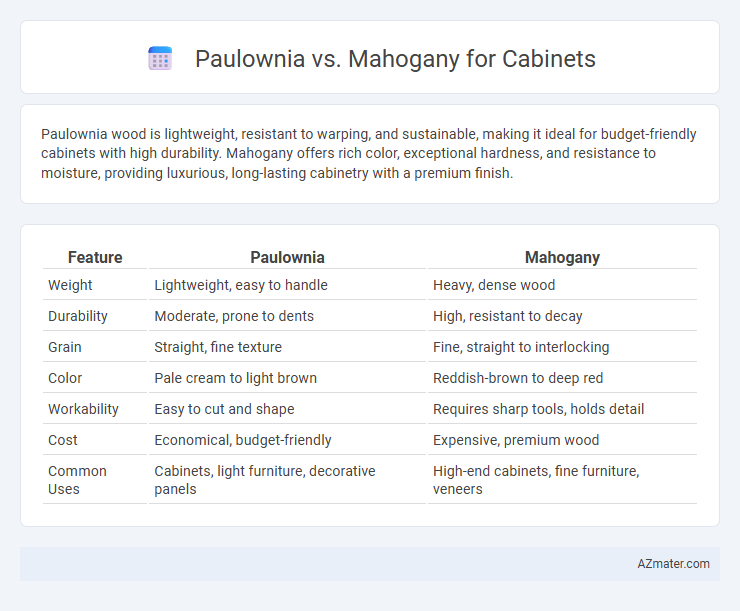Paulownia wood is lightweight, resistant to warping, and sustainable, making it ideal for budget-friendly cabinets with high durability. Mahogany offers rich color, exceptional hardness, and resistance to moisture, providing luxurious, long-lasting cabinetry with a premium finish.
Table of Comparison
| Feature | Paulownia | Mahogany |
|---|---|---|
| Weight | Lightweight, easy to handle | Heavy, dense wood |
| Durability | Moderate, prone to dents | High, resistant to decay |
| Grain | Straight, fine texture | Fine, straight to interlocking |
| Color | Pale cream to light brown | Reddish-brown to deep red |
| Workability | Easy to cut and shape | Requires sharp tools, holds detail |
| Cost | Economical, budget-friendly | Expensive, premium wood |
| Common Uses | Cabinets, light furniture, decorative panels | High-end cabinets, fine furniture, veneers |
Introduction to Paulownia and Mahogany
Paulownia is a lightweight, fast-growing hardwood known for its stability, resistance to warping, and light color, making it ideal for modern, eco-friendly cabinet designs. Mahogany, prized for its rich reddish-brown hue, dense grain, and durability, offers a traditional, elegant look favored in high-end cabinetry. Both woods provide unique aesthetic and functional qualities, with Paulownia excelling in sustainability and ease of working, while Mahogany is valued for its timeless beauty and strength.
Botanical Background and Origins
Paulownia, scientifically known as Paulownia tomentosa, is native to central and western China and thrives in temperate climates, where it grows rapidly and is valued for its lightweight and fine-grained wood. Mahogany, primarily derived from Swietenia species native to Central and South America, is renowned for its dense, durable hardwood with a rich reddish-brown color, making it a preferred choice for high-end cabinetry. Both woods offer distinct botanical traits and origins that influence their texture, density, and suitability for cabinet construction.
Wood Grain and Appearance Comparison
Paulownia wood features a light color with a straight, uniform grain pattern that creates a smooth, contemporary look ideal for modern cabinetry. Mahogany offers a richer, reddish-brown hue with a more pronounced interlocking grain, providing depth and a classic, luxurious appearance suited for traditional or high-end cabinets. Both woods exhibit unique grain characteristics that influence cabinet aesthetics, with Paulownia delivering a lighter and more subtle visual texture, while Mahogany presents warmth and elegance through its distinctive grain complexity.
Strength and Durability Differences
Paulownia wood is lightweight with moderate strength, making it less durable and more prone to dents and scratches in cabinet construction compared to mahogany. Mahogany offers superior hardness, resistance to wear, and excellent dimensional stability, ensuring long-lasting durability in cabinetry. For high-traffic or heavy-use cabinets, mahogany is a stronger, more resilient choice than the softer, more flexible paulownia.
Weight and Workability Factors
Paulownia wood is significantly lighter than mahogany, making it ideal for cabinets that require easy handling and installation without compromising strength. Its soft texture and low density enhance workability, allowing for smooth cutting and shaping compared to the denser and harder mahogany wood. Mahogany, while heavier, offers superior durability and a fine grain that provides a high-end finish but demands more effort during machining and joinery.
Resistance to Pests and Decay
Paulownia wood exhibits high resistance to pests and decay due to its natural oils and low moisture content, making it a durable choice for cabinets in humid environments. Mahogany also offers excellent resistance to rot and insect damage, attributed to its dense grain and natural tannins, which protect the wood over time. While both woods provide durability, Mahogany's long-standing reputation in fine woodworking often positions it as the superior option for pest and decay resistance in cabinetry.
Environmental Impact and Sustainability
Paulownia wood is highly sustainable due to its rapid growth rate and ability to regenerate quickly after harvesting, making it an eco-friendly choice for cabinets. In contrast, mahogany, often sourced from slow-growing tropical rainforests, faces significant deforestation concerns and stricter regulations to protect endangered species. Choosing paulownia supports sustainable forestry practices and reduces the carbon footprint associated with cabinet production compared to mahogany.
Cost and Availability Analysis
Paulownia wood offers a cost-effective alternative to mahogany, with significantly lower prices due to its rapid growth and renewable supply, making it highly accessible for cabinetry projects. Mahogany, known for its luxurious appearance and durability, commands a premium price and is less readily available because of slower growth rates and restricted harvesting regulations. The choice between these woods depends on budget constraints and desired exclusivity, with paulownia favored for affordability and sustainability, while mahogany is selected for high-end cabinetry requiring rich aesthetics and long-term value.
Best Applications in Cabinetry
Paulownia wood offers lightweight properties and excellent resistance to warping, making it ideal for cabinet interiors and lightweight storage solutions, especially in humid environments. Mahogany's dense grain, durability, and rich reddish-brown color suit high-end cabinetry where strength and aesthetic appeal are paramount. For cabinet fronts and decorative panels, mahogany provides superior refinement, while paulownia excels in applications requiring moisture resistance and easy handling.
Verdict: Choosing Between Paulownia and Mahogany for Cabinets
Paulownia offers lightweight durability and rapid growth, making it an eco-friendly and cost-effective choice for cabinets, while mahogany provides superior hardness, rich grain, and long-lasting elegance, ideal for high-end cabinetry. For budget-conscious projects prioritizing sustainability and ease of handling, paulownia delivers excellent value and practicality. Mahogany remains the preferred option for luxury cabinets requiring robust strength, deep coloration, and refined finishes that stand the test of time.

Infographic: Paulownia vs Mahogany for Cabinet
 azmater.com
azmater.com